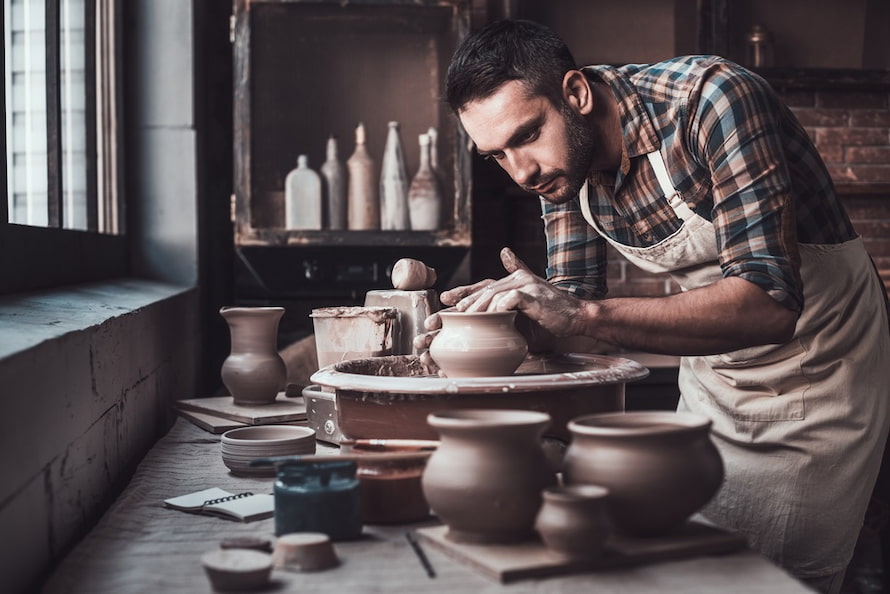source: potteryandcrafting.com



Lifestyle
Pottery Banding Wheel: A Humble Tool with a Vital Role in Ceramics
When it comes to ceramics, precision and control are paramount. Every movement, every touch of the hand, shapes the final piece. Among the arsenal of supplies available to ceramic artists, the banding wheel stands out as an indispensable ally. These trusty spinning platforms are a staple in any potter’s toolkit. They may seem simple at first glance, but they play a vital role in the creation of beautiful ceramic pieces.
What Are Banding Wheels?

source: ceramicartsnetwork.org
First off, what exactly is a pottery banding wheel? Well, think of it as a lazy Susan for pottery. It’s a rotating disc mounted on a base that allows potters to spin their work while they decorate, glaze, or shape it. This spinning motion provides smooth, consistent movement, making it easier for artists to apply intricate designs or even out the surface of their pieces.
Now, why are they called “banding” wheels? The term “banding” refers to the process of applying bands or lines of decoration to a piece of pottery. They facilitate this technique by allowing artists to rotate their work as they apply these decorative elements. It’s all about precision and control, giving potters the ability to create symmetrical designs and patterns with ease.
One of the great things about the versatile and easy-to-use banding wheel is the fact that they come in various sizes and materials, from small tabletop models to larger floor-standing ones. Some are made of durable materials like metal or cast iron, while others feature a smooth, rotating disc made of plaster or plastic.
How Do You Use One?
So, how do you use a banding wheel for ceramics? It’s pretty straightforward. You place your piece of pottery on the rotating disc, securing it in place if necessary. Then, with a steady hand, you can spin the wheel as you work your magic. Whether you’re painting delicate designs, trimming excess clay, or applying glaze, it helps you maintain a steady rhythm and consistent results.
But these wheels aren’t just for decoration – they’re also handy for practical tasks like trimming and sculpting. By spinning your piece on the wheel, you can access all sides easily, making it simpler to trim excess clay or refine the shape of your creation. It’s like having an extra set of hands, giving you more control and flexibility as you work on the following:
- Handbuilding: These tools are invaluable for hand-building techniques such as coiling, pinching, and slab construction. The ability to rotate the piece smoothly facilitates even shaping and uniform thickness.
- Decoration: Whether applying glazes, carving intricate designs, or painting delicate patterns, the rotation of the banding wheel enables precise and controlled embellishment of ceramic surfaces.
- Trimming and Finishing: When trimming excess clay or refining the shape of a piece on the wheel, a banding wheel provides the necessary rotation for smooth, consistent cuts and finishes.
- Modelling and Sculpting: Sculptors and modellers use them to sculpt clay into three-dimensional forms, rotating the piece as they work to view it from all angles and maintain symmetry.
- Display and Photography: The wheels are not only functional tools but also aesthetically pleasing objects in their own right. They can be used to showcase finished pieces or to facilitate photography by allowing easy rotation for capturing different angles.
How to Choose a Banding Wheel?
- Consider Your Needs: Assess your specific requirements based on the scale of your projects, your preferred techniques, and the level of mobility you need. This will help determine the size, weight, and features that best suit your workflow.
- Evaluate Construction: Examine the quality of construction and materials to ensure durability and longevity. Choose a pottery wheel that can withstand the demands of your creative process and environment.
- Test Rotation: Prioritize smooth, effortless rotation when testing different models. Look for options with reliable rotational mechanisms that operate quietly and consistently.
- Check Stability: Stability is crucial for precision work. Test the stability of the wheel by applying pressure to the surface and observing for any wobbling or instability.
- Review Adjustability: If adjustability is important to you, such as adjustable height or tilt, ensure that the banding wheel offers the flexibility you need to optimize your working position.
- Read Reviews: Seek feedback from other ceramic artists and read reviews of different models to gain insights into their performance, reliability, and overall satisfaction.
Some Care Goes a Long Way

source: artnews.com
Of course, like any tool, pottery banding wheels require a bit of care and maintenance to keep them in tip-top shape. Regular cleaning and lubrication of the rotating mechanism will ensure smooth operation while inspecting the base for stability will prevent wobbling or uneven spinning. With proper care, it will serve you faithfully for years to come.
Wrapping Up
Pottery wheels are humble yet indispensable tools for any ceramic artist. They provide stability, precision, and versatility, making them invaluable for a wide range of tasks from decoration to sculpting. So, whether you’re a seasoned pro or just starting out, consider adding one to your arsenal – you won’t regret it!












